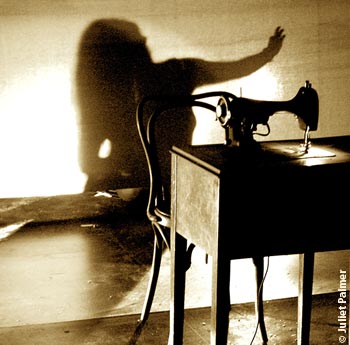| Three women in the shadows feed cloths into sewing machines. Their concentration is palpable. The sewing machines, whose sound constitutes the only fixed pitch in the room, drone deadeningly. Something about their unreadable stone-faced expressions reminds me of the three fates, three goddesses from Greek mythology whose tasks are to begin, to lengthen, and to cut off threads that correspond to people’s lives. Whereas the three fates are spinners, these three women are dressed and arranged to evoke a 19th century dressmaker’s workshop. Both groups, however, belie the mindless repetition, the stifling constraint of women’s tasks, with the deadly seriousness of their work’s true nature. In the midst of their submission to their roles, something dark and ungovernable is taking place. |
|
 |
|
| Stitch: an a cappella opera for 3 women and 3 sewing machines contained many elements of the dark and ungovernable. Beginning in the foyer of the performance space, the three women, Christine Duncan, Patricia O’Callaghan, and Neema Bickersteth, arranged themselves on a tiered dais and proceeded to set up a drone of their own, that increased in volume and resonance as they ripped apart cloths with mounting ferocity. “Clothes for clones,” sang O’Callaghan, early on, “close my mouth with pins,” she later added. The libretto was relatively sparse in this piece. Certainly more was expressed in the tension and release of the frighteningly difficult score than in the few, but striking words sung by the characters — if indeed they can be called that.
None of the women were consistently referred to by one name, and little of their behaviour seemed calculated to induce a belief in their existence as coherent entities. Rather, as each woman moved into focus, a situation developed around her, to which the other two would supply supportive or counterpoint presences. This structure was wildly evocative. I only decided several days later that no one story had been told, but that the show was a distillation of several situations and experiences, encoded into musical form and making use of sewing terminology. Frankly, I’m not sure non-sewers like myself had full access to the double-meanings of the sewing jargon. Some people in the audience were getting jokes about portrait-collars and whip-stitches that I’m sure I found funny for the wrong reason.
Juliet Palmer has written a troubling and exhilarating opera, and hats off to the seriously skilled singers who sang it all, clusters, dissonances, bluesy interludes and yes, the screaming under the sewing table. The thing would have been a nightmare to learn, never mind to sing without pitch reference, aside from the sewing machine motor. Add to that the movement work, the dramatic suggestion without explicit plot, and you have a rare combination of qualities, one that thrills and challenges audiences, and raises the bar for all such works to follow.
|


